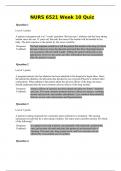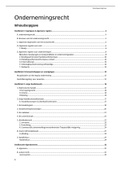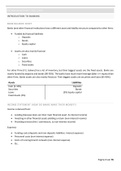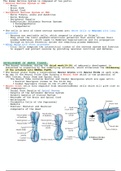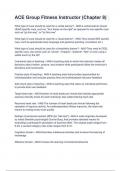HC 1:
Introduction to Supply Chain Management
Chapter 1
1.1. What is Supply Chain Management
Supply chain management is a set of approaches
utilized to efficiently integrate suppliers,
manufacturers, warehouses, and stores, so that
merchandise is produced and distributed at the
right quantities, to the right locations, and at the
right time, in order to minimize system wide costs
while satisfying service level requirements
What makes SCM difficult?
1. Supply chain strategies cannot be determined in isolation. They are directly affected by
another chain that most organizations have, development chain.
2. It is challenging to design and operate a supply chain so that total systemwide costs are
minimized, and systemwide service levels are maintained.
3. Uncertainty and risk are inherent in every supply chain.
1.2 The development chain
= the set of activities and processes associated with new
product introduction. It includes the product design
phase, the associated capabilities and knowledge that
need to be developed internally, sourcing decisions, and
production plans. See figure 1-2.
1.3 Global Optimization
What makes finding the best systemwide, or globally
optimal, integrated solution so difficult?
- The supply chain is a complex network
- Different facilities in the supply chain frequently
have different, conflicting, objectives. For
instance, manufacturers want to ship in large batches but retailers do not have a stable
demand, so they want smaller batches.
- The supply chain is a dynamic system that evolves over time → Customer demand change,
supplier capabilities change, supply chain relationships change.
- System variations over time
1.4. Managing uncertainty and risk
Factors:
1. Matching supply and demand is a major challenge
2. Inventory and back-order levels fluctuate considerably across the supply chain
3. Forecasting doesn’t solve the problem. Predicting precise demand is impossible.
4. Demand is not only source of uncertainty → delivery lead times, manufacturing yields,
transportation times, and component availability
, 5. Trends such lean manufacturing, outsourcing and offshoring focus on cost reduction increase
risks significantly.
1.5. The evolution of supply chain management
Transportation cost is by far the largest cost
component; inventory cost is slightly higher than half of
the transportation costs.
Strategic partnerships between suppliers and buyers
can help both parties reduce their costs.
Information sharing between partners can help to
better predict demand and reduce lead times.
The supply chain has become much more complex.
1.6. The Complexity
Three critical abilities that successful firms must possess:
1. The ability to match supply chain strategies with product characteristics. The intersection of
the development chain and the supply chain has an impact on both product design and
supply chain strategy.
2. Replace traditional supply chain strategies by those that yield a globally optimized supply
chain.
3. Manage uncertainty and risk
1.7. Key Issues in SCM
Different decisions levels within an organization:
- Strategic level deals with decisions that have a long-lasting effect on the firm. →product
design, what to make internally, what to outsource, supplier selection, strategic partnering.
Number, location and capacity of warehouses and manufacturing plants and the flow of
material through the logistics network.
- Tactical level: decisions updated between once every quarter and once every year. →
purchasing and production decisions inventory policies and transportations strategies.
- Operational level: day-to-day decisions → scheduling, lead time quotations, routing and
truck loading.
- Distribution Network Configuration – Reorganizing and redesigning the distribution network
(warehouse locations, new suppliers, changing demand, transportation flows) is a complex
optimization problem, and advanced technology and approaches are required to find a
solution.
- Inventory control – minimize ordering and holding cost. Demand changes over time, how
much is the order size etc.
- Product Sourcing – reducing production costs typically implies that each manufacturing
facility is responsible for a small set of products so that large batches are produced. → this
may lead to higher transportation costs. Bigger set of products → small batches → higher
production costs but lower transportation costs. Need to find a balance.
- Supply Contracts – contracts with your suppliers with pricing and volume discounts
- Distribution Strategies – Centralized or decentralized distribution systems. Organizations
face this challenge what to decide.
- Supply Chain Integration and Strategic Partnering
- Outsourcing and Offshoring Strategies
- Product Design
- Information Technologies and Decision-Support Systems
- Customer Value
, - Smart Pricing – the firm integrates pricing and inventory to influence market demand and
improve the bottom line (as airlines, hotels and car rentals do).
HC 2
Inventory management
- How much to order?
- When to order?
When demand is independent, it is driven by
external forces outside of the firm.
In case internal management decisions drive
demand, it is said to be dependent demand.
Pull systems react to actual demand and execute replenishments in response to this
demand. Authorize releases on information from inside the system.
Push systems drive replenishments from the schedule of projected future
demands, which will vary over time. Schedule work releases on the basis of info outside of the
system.
Describing demand
- Stationary: expected demand same in all periods
o Sufficient to describe demand for a period of the time horizon
o When not known with certainty: probability distribution
- Non Stationary
o At small number of points across time horizon: probability distribution
o At large number of points across time horizon: forecasting
Estimating relevant costs
- Costs related to an order
- Inventory holding costs
- Shortage costs
A-B-C Classification
Pareto principle (20/80): This rule does not always hold, however it is assumed that about 50% of the
items are categorized as C items, 30% as B and 20% as A.
- Class A:
o First 10-20% of SKUs, around 50-75% of volume
o Should be monitored closely
- Class B:
o Next 30-50% of SKUs, around 20-30% of volume
o Require a moderate yet significant amount of attention
- Class C:
o Remaining SKUs, remaining 5 to 10% of volume
o Decision systems must be kept as simple as possible
o Class C can be very important as well. You do not sell them that often but it can be
important for
▪ customer loyalty → otherwise people buy from your competitor.
▪ A lot of money can be invested in class C products
ABC analysis separates inventory into three categories. A items are the most important
items and require the most attention. B items are less important but still require a moderate
, level of attention and C items requires the least attention. Usually the item sales revenue or
item cost of goods sold are used as the measure of interest. However, other factors should be taken
into account as well: item criticality, required customer service.
Multi-dimensional A-B-C analysis
- E.g. 2 way classification on sales volume and criticality
Single item, single period
Discrete demand – Marginal analysis
The Newsvendor problem
Because demand in the newsvendor problem is uncertain and concentrated into a point e.g.
the time to order newspapers and receive them is longer than the selling period of 1 day.
For these two reasons it is necessary to describe a probability distribution.
Next to the demand we need to describe the relevant costs such as: cost of the item, failing
to fulfil demand, post-selling-period value of the item.
Example:
Heaters (cost 1000, price 2000, salvage value 500)
1 2 3 4 5 Units (Q)
0,2 0,3 0,3 0,1 0,1 Probability
The cost of missing a sale = P – C
The cost of excess units at the end of the selling season = C – S
The optimal order quantity maximizes expect profit, given by:
Q*=3
Expected profit:
Profit on each unit sold is (p-c)
(p-c) * P(D=>Q)
(2000 – 1000) * 0,5 = €500 profit
0,5 = 0,3 + 0,1 + 0,1 → D=>3
Expected loss:
(c-s) * P(D<Q)
(1000-500) * 0,5 = €250 loss
0,5 = 0,2 + 0,3 → D<3
Optimum: expected profit equals expected loss
How to determine Q*?
- Marginal analysis focusses on what happens to the Qth unit
o If Q is very small: large probability of selling unit, expected profit unit >> expected
loss
o If Q is very large: low probability of selling unit, expected profit unit << expected loss
- Increase order size until no longer profitable
- We only buy Q items if the expected profit is larger or equal to expected loss
𝑐−𝑠
Calculate ratio: 𝑃(𝐷 ≥ 𝑄) ≥ 𝑝−𝑠
Optimal Q is largest value for which the equality holds
- Start with a small value of Q



